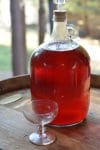Description
Chokecherries are rich in antioxidants and anthocyanins. Elderflowers, too, help fight winter colds and flu symptoms. This honey mead will preserve the goodness of summer herbs and fruit for winter.
Ingredients
Scale
- 1 cup of elderflowers, de-stemmed
- ½ cup of rose petals
- 8 – 10 cups of water, filtered, divided
- 3 cups honey
- 6 lbs. Chokecherries or 6 cups of chokecherry juice
- 1/2 cup of grape juice concentrate
- ¼ teaspoon champagne wine yeast
Instructions
- Place elderflowers and rose petals in a 2 quart, heat proof bowl. Pour 4 cups of boiling water over them and cover. Let steep for 1 hour, covered. Strain the tea. Stir the honey into the warm tea. Set aside.
- Meanwhile, remove the stems from the chokecherries and place them in a steam juicer. Steam until the juice flows freely. If you don’t have a steam juicer, simmer the cherries in a pot with 2 cups of water for 30 minutes until cherries are steaming. Strain through a jelly bag or through cheese cloth. It’s alright to squeeze the jelly bag to retain as much juice as possible. While the juice will be cloudy it will clear during the fermentation process.
- Reserve the juice. Discard the pulp and seeds.
- Sanitize a 1 gallon glass fermenting jug, along with its tin cap. Pour the herb and honey mixture into the fermenting jug. Add the chokecherry juice.
- Pour the grape juice concentrate into a glass. Stir in 1 cup of water. Allow it to come to room temperature. Sprinkle the yeast over top of the grape juice. Wait 30 minutes. Stir the yeast into the grape juice and wait till it becomes frothy or bubbly.
- Pour the grape juice – yeast mixture into the fermentation jug. Cap the jug and shake it for a few minutes to finish dissolving both the yeast and the honey. Add the cooled honey-herb tea to the fermentation jug. Top up the jug to the shoulders with boiled and cooled filtered water.
- Sanitize a wine fermentation lock. Fill the fermentation lock with boiled and cooled water. Replace the cap on the fermentation jug with the fermentation lock.
- Place the jug on a plate to catch any overflow. Place the jug in a spot out direct sunlight and away from source of heat, for several weeks. The fermentation will become active with bubbling and frothing evident.
Racking off
- After 4 to 6 weeks you’ll notice that the fermentation has slowed down and sediment is forming in the bottom of the jug. The mead is still not clear though. When the bubbling and frothing stop, transfer the liquid to a fresh, sanitized fermentation jug. Sanitize the fermentation lock again and place it on the new fermentation jug. The fermentation process will resume.
Clear the mead
- This last fermentation can take anywhere from 2 to 6 weeks. When the fermentation stops, the wine will clear. If it doesn’t clear naturally add ¼ teaspoon of pectinase to the jug. Replace the fermentation lock and wait.
Bottle the mead
- When the wine clears and fermentation stops, siphon the mead into sanitized wine bottles. Cap with a wine corker or a twist cap according to your bottles. Label the bottles.
- Place the wine bottles in a cool, dark spot. Age at least 3 months before sampling. Mead get better the longer it sits.
Notes
Use the wine to stay healthy in winter and to ward off cold and flu symptoms. Or just enjoy this sparking, ruby red, mead, full of healthy antioxidants.
